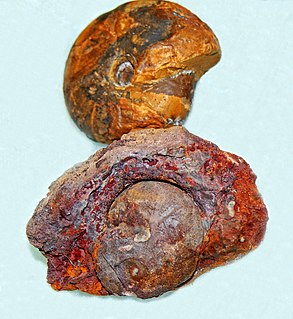Related Research Articles

Ammonoids are an extinct group of marine mollusc animals in the subclass Ammonoidea of the class Cephalopoda. These molluscs, commonly referred to as ammonites, are more closely related to living coleoids than they are to shelled nautiloids such as the living Nautilus species. The earliest ammonites appear during the Devonian, and the last species died out in the Cretaceous–Paleogene extinction event.

Redlichiida is an order of trilobites, a group of extinct marine arthropods. Species assigned to the order Redlichiida are among the first trilobites to appear in the fossil record, about halfway during the Lower Cambrian. Due to the difficulty to relate sediments in different areas, there remains some discussion, but among the earliest are Fallotaspis, and Lemdadella, both belonging to this order. The first representatives of the orders Corynexochida and Ptychopariida also appear very early on and may prove to be even earlier than any redlichiid species. In terms of anatomical comparison, the earliest redlichiid species are probably ancestral to all other trilobite orders and share many primitive characters. The last redlichiid trilobites died out before the end of the Middle Cambrian.

In botany a capsule is a type of simple, dry, though rarely fleshy dehiscent fruit produced by many species of angiosperms.

Phacopidae is a family of phacophid trilobites that ranges from the Lower Ordovician to the Upper Devonian, with representatives in all paleocontinents.

Beyrichoceras is a genus belonging to the Goniatitid family, Maxigoniatitidae that lived during the Mississippian Period
Noritaceae is an extinct superfamily of cephalopods belonging to the Ammonite order Ceratitida.
The Posttornoceratidae are Late Devonian goniatites (Ammonoidea) included in the superfamily Tornocerataceae. The Family, Posttornoceratidae, named by Bogoslovsky in 1962, is based on the genus Posttornoceras, named by Wedekind in 1910, originally included in the Tornoceratidae.

Aturia is an extinct genus of Paleocene to Miocene nautilids within Aturiidae, a monotypic family, established by Campman in 1857 for Aturia Bronn, 1838, and is included in the superfamily Nautilaceae in Kümmel 1964.
Prolecanitida is an order of extinct ammonoid cephalopods with discoidal to thinly lenticular shells with goniatitic or ceratitic sutures and which retained the simple retrochoanitic siphuncle with backward extending septal necks. As typical for ammonoids the siphuncle is along the ventral margin. Prolecanitids form a relatively small and stable order within the Ammonoidea with 43 named genera and about 1250 species, but with a long-ranging lineage of about 108 m.y. stretching from the Lower Carboniferous to the Triassic. Although not as diverse as their goniatitid contemporaries, the Prolecanatida provided the stock from which all later Mesozoic ammonoids were derived.

The Trigonocerataceae are a superfamily within the Nautilida that ranged from the Devonian to the Triassic, thought to have contained the source for the Nautilaceae in which Nautilus is found.
The Centroceratidae is the ancestral family of the Trigonocerataceae and of the equivalent Centroceratina; extinct shelled cephalopods belonging to the order Nautilida
Condraoceras is a genus of liroceratids from the Pennsylvanian of North America and Lower Permian of Europe with a compressed, involute, nautiliconic shell; subcircular whorl section; small umbilicus with a rounded shoulder; suture with shallow ventral and lateral lobes; and narrow subcentral siphuncle.
Liroceras is a genus of Nautiloid Cephalopod. It is the type genus of the clydonautiliacean family, Liroceratidae, and is characterized by a rapidly expanding, subglobular, nautiliconic shell with a reniform whorl section, small umbilicus, essentially straight sutures, and a siphuncle with a variable but not marginal position.
Gonionautilidae is a family in the nautilid superfamily Clydonautiliaceae that contains only the genus Gonionautilus, known from the Upper Triassic (Norian) of Europe and North America.
The Uddenitinae a subfamily of the Medlicottiidae, a family of ammonoid cephalopods included in the Prolecanitida. The Uddenitinae, proposed by Miller and Furnish, and known from the Pennsylvanian and Lower Permian, are transitional between the ancestral Pronoritidae and the more traditional medlicottiids
Raymondiceratinae is a subfamily of Upper Devonian cheiloceratid goniatites in which the sutures have 4 distinct lobes and the growth lines are convex. The subfamily includes three genera.
Gundolficeras is member of the Tornoceratidae,, from the Late Devonian named by Becker, 1995 and assigned to the Falcitornoceratinae. The type species is "Lobotornoceras" bicaniculatum.
Proclydonautilus is a genus of nautiloids belonging to the Clydonautilidae known from the Upper Triassic of North America, Europe, and India.
Eowellerites is genus of ammonoid cephalopods belonging to the Welleritidae family. Species belonging to this genus lived in middle Pennsylvanian (Moscovian). Its fossils were found in USA and Japan. It had thinly discoidal shells with a quite wide umbilicus (U/D = 0.3 - 0.5). While in juvenile stages (up to 15 mm in diameter) venter is moderately rounded, it becomes slightly rounded to flattened when becoming mature (100 mm in diameter). 12-lobed suture has adventitious lobe on the first lateral saddle and is also characterized by an addition of an umbilical lobe. Sutural formula is (V1 V1) L1 L (U1 U2): I D. It has evolved from Winslowoceras henbesti and gave rise to genus Wellerites.
References
- Bernhard Kummel, 1964. Nautiloidea -Natilida. Treatise on Invertebrate Paleontology, Part K. Geological Society of America and University of Kansas Press.
| This prehistoric nautiloid-related article is a stub. You can help Wikipedia by expanding it. |